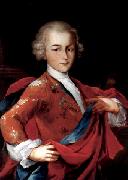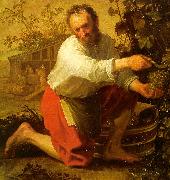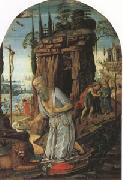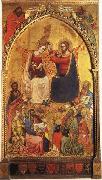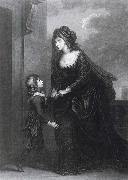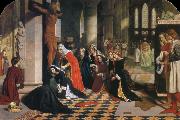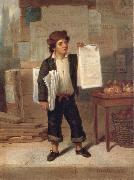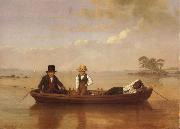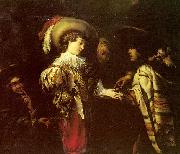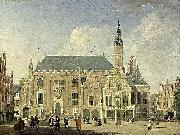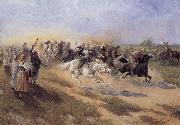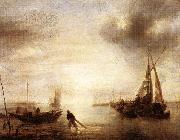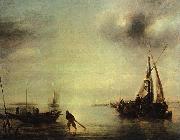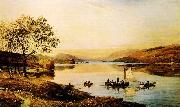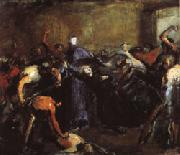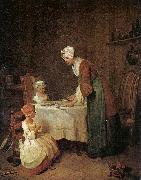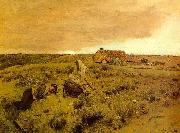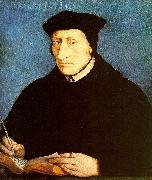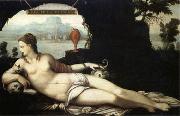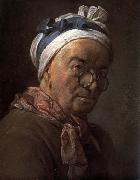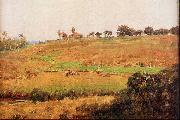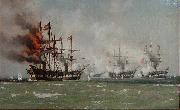|
|
|
|
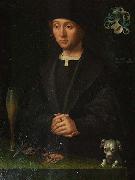 |
Jacob Claesz van Utrecht
|
|
also named by his signature Jacobus Traiectensis (born c. 1479 - dead after 1525) was a Flemish early Renaissance painter who worked in Antwerp and Lebeck.
Jacob van Utrecht's life is still very much in the dark. Research on this important Flemish artist did not start before the end of 19th century. He was probably born in Utrecht, although it is not certain. It is assumed that he became a citizen of Antwerp around 1500 and he is recorded as a "free master craftsman" of the Guild of St Luke there from 1506 to 1512.
From 1519 to 1525 he is recorded as a member of the Leonardsbruderschaft ("Leonard's Brotherhood"), a religious confraternity of merchants in Lebeck among whose ranks the leaders of the Protestant Reformation in the 1530s could be found.
From then on no traces of his life have been found.
|
|
|
|
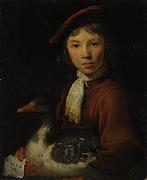 |
Jacob Gerritsz. Cuyp
|
|
was a portrait and landscape painter. He was born and died in Dordrecht, and was the half-brother of Benjamin Gerritsz Cuyp and the father of the much more famous Aelbert Cuyp.
According to Houbraken, he helped the painters Jacques de Claeuw, Isaac van Hasselt, and Cornelis Tegelberg set up a Guild of Saint Luke in Dordrecht in 1642.
|
|
|
|
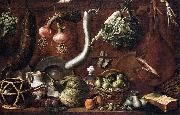 |
Jacopo Chimenti
|
|
(30 April 1551 - 30 September 1640) was an Italian late-mannerist painter.
Born in Florence as Jacopo Chimenti (Empoli being the birth place of his father), he worked mostly in his native city. He apprenticed under Maso da San Friano. Like his contemporary in Counter-Maniera (Counter-Mannerism), Santi di Tito, he moved into a style often more crisp, less contorted, and less crowded than mannerist predecessors like Vasari. He collaborated with Alessandro Tiarini in some projects. Among his pupils were Felice Ficherelli, Giovanni Battista Brazze (Il Bigio), Giovanni Battista Vanni, and Virgilio Zaballi.
In later years, the naturalism becomes less evident. The porcelain features of his figures accentuated the academic classical trends that restrained Florentine painting during the Baroque period. |
|
|
|
|
|
|
|
|
|
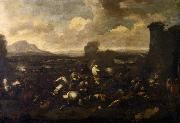 |
Jacques Courtois
|
|
(also called 'il Borgognone' or Giacomo Borgognone) (1621 - 20 May 1676?) was a French painter.
He was born at Saint-Hippolyte, near Besançon. His father was a painter, and with him Jacques remained studying up to the age of fifteen. Towards 1637 he went to Italy, was received at Milan by a Burgundian gentleman, and entered, and for three years remained in the French military service.
The sight of some battle-pictures revived his taste for fine art. He went to Bologna, and studied under the friendly tutelage of Guido Reni; thence he proceeded to Rome, where he painted, in the Cistercian monastery, the "Miracle of the Loaves." Here he took a house and after a while entered upon his own characteristic style of art, that of battle-painting, in which he has been accounted to excel all other old masters; his merits were cordially recognized by the celebrated Cerquozzi, named Michelangelo delle Battaglie.
He soon rose from penury to ease, and married a painter's daughter, Maria Vagini; she died after seven years of wedded life. Prince Matthias of Tuscany employed Courtois on some striking works in his villa, Lappeggio, representing with much historical accuracy the princes military exploits. In Venice also the artist executed for the senator Sagredo some remarkable battle-pieces. In Florence he entered the Society of Jesus, taking the habit in Rome in 1655; it was calumniously rumoured that he adopted this course in order to escape punishment for having poisoned his wife.
As a Jesuit Brother, Courtois painted many works in churches and monasteries of the society. He lived piously in Rome, and died there of apoplexy on 20 May 1676 (some accounts say 1670 or 1671).
His battle-pieces have movement and fire, warm colouring (now too often blackened), and great command of the brush, those of moderate dimensions are the more esteemed. They are slight in execution, and tell out best from a distance. Courtois etched, with skill twelve battle-subjects of his own composition. The Danzig painter called Pandolfo Reschi in Italy was his pupil.
His brother Guillaume was also a painter in Italy.
|
|
|
|
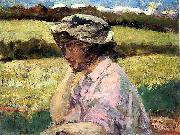 |
James Carroll Beckwith
|
|
(September 23, 1852 - October 24, 1917) was an American landscape, portrait and genre painter whose Impressionist style led to his recognition in the late nineteenth century as a prominent figure in American art.
Carroll Beckwith, as he preferred to be known, was born in Hannibal, Missouri on 23 September 1852, the son of N. M. Beckwith, who was United States Commissioner-General at the Paris Exposition of 1867. However, he grew up in Chicago where his father started a wholesale grocery business. In 1868 aged 16 he studied art at the Chicago Academy of Design under Walter Shirlaw until the great fire of 1871 destroyed eveything (including much of the heart of the city). He then went to New York and studied at the National Academy of Design (of which he afterwards became a member) in New York City under Lemuel Wilmarth and later traveled on to Paris, staying there from November 1873 until 1878.
|
|
|
|
|
|
|
|
|
|
|
|
james m cain
|
|
Born: 1 July 1892
Birthplace: Annapolis, Maryland
Died: 27 October 1977
Best Known As: Author of The Postman Always Rings Twice
|
|
|
|
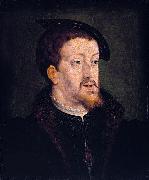 |
Jan Cornelisz Vermeyen
|
|
(c.1500-1559) was a Dutch Northern Renaissance painter.
According to Karel van Mander he was born in Beverwijk in 1500 and was honored for his career in the service of Charles V. He was a friend of Jan van Scorel and his portrait was engraved by Jan Wierix for Dominicus Lampsonius.
Vermeyen was a painter and tapestry designer, probably a pupil of Jan Mabuse. About 1525 he became Court Painter to Margaret of Austria, regent of the Netherlands at Mechelen and in 1535 he accompanied the Emperor Charles V, at the Conquest of Tunis (1535). This journey supplied him with scenes for later works, including tapestries designed 1545/48 for the Regent, Mary of Hungary. He died in Brussels.
Many portraits are ascribed to him on very little evidence, according to modern scholars.
|
|
|
|
|
|
|
|
|
|
|
|
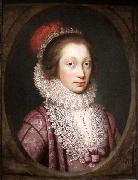 |
Janssens van Ceulen
|
|
Cornelis Janssens van Ceulen (also Cornelius Jonson van Ceulen, Cornelius Johnson, Cornelis Jansz. van Ceulen and many other variants) (bapt. October 14, 1593, London - bur. August 5, 1661, Utrecht) was an English painter of portraits of Dutch or Flemish parentage. He has been described as "one of the most gifted and prolific portrait painters practising in England during the 1620s and 1630s".
|
|
|
|
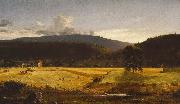 |
Jasper Francis Cropsey
|
|
(February 18, 1823 - April 23, 1900) was an important American landscape artist of the Hudson River School.
Cropsey was born on his father Jacob Rezeau Cropsey's farm in Rossville on Staten Island, New York, the oldest of eight children. As a young boy, Cropsey had recurring periods of poor health. While absent from school, Cropsey taught himself to draw. His early drawings included architectural sketches and landscapes drawn on notepads and in the margins of his schoolbooks.
Trained as an architect, he set up his own office in 1843. Cropsey studied watercolor and life drawing at the National Academy of Design under the instruction of Edward Maury and first exhibited there in 1844. A year later he was elected an associate member and turned exclusively to landscape painting; shortly after he was featured in an exhibition entitled "Italian Compositions."
Cropsey married Maria Cooley in May 1847, traveled in Europe from 1847-1849, visiting England, France, Switzerland, and Italy. He was elected a full member of the Academy in 1851. Cropsey was a personal friend of Henry Tappan, the president of the University of Michigan from 1852 to 1863. At Tappan's invitation, he traveled to Ann Arbor in 1855 and produced two paintings, one of the Detroit Observatory, and a landscape of the campus. He went abroad again in 1855, and resided seven years in London, sending his pictures to the Royal Academy and to the International exhibition of 1862.
Returning home, he opened a studio in New York and specialized in autumnal landscape paintings of the northeastern United States, often idealized and with vivid colors. Cropsey co-founded, with ten fellow artists, the American Society of Painters in Water Colors in 1866. He resided in the City until 1885, when he removed to Hastings-on-Hudson.
The monument of Jasper Francis Cropsey in Sleepy Hollow CemeteryCropsey's home and studio, Ever Rest, in Hastings-on-Hudson, New York as well as the largest permanent collection of Cropsey's work are open for tours by the Newington-Cropsey Foundation.
Jasper Cropsey died in anonymity but was rediscovered by galleries and collectors in the 1960s. Today, Cropsey's paintings are found in most major American museums, including the National Gallery of Art, the Metropolitan Museum of Art, the Los Angeles County Museum of Art, the Detroit Institute of Arts, the Timken Museum of Art in San Diego, the Honolulu Academy of Arts, the Fine Arts Museums of San Francisco, the Denver Art Museum, and the Museum of Fine Arts, Boston. Works by Cropsey also hang in the White House. |
|
|
|
|
|
|
|
|
|
|
|
|
|
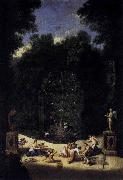 |
Jean Cotelle
|
|
Jean Cotelle
Jean Cotelle, 'the younger', was a painter and engraver, born in Paris in 1645. He received his early instruction from his father, Jean Cotelle, and eventually visited Italy. On his return he devoted himself to his profession, producing historical paintings, miniatures, and occasionally etchings. His chef-d'oeuvre was the 'Marriage at Cana,' painted in 1681 for the cathedral of Notre-Dame. There are by him at Versailles several views in the gardens of that palace. He etched a plate representing 'Our Lord on the Mount of Olives,' and a series of seven scenes from the history of Venus. He was admitted into the Academy in 1672, and died at Villers-sur-Marne in 1708. |
|
|
|
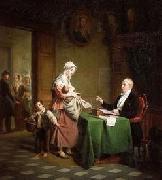 |
Jean Henri De Coene
|
|
Jean Henri De Coene, a Belgian painter of genre and historical subjects, was born at Nederbrakel in 1798. |
|
 |
Jean Simeon Chardin
|
|
(2 November 1699 - 6 December 1779) was an 18th-century French painter. He is considered a master of still life, and is also noted for his genre paintings which depict kitchen maids, children, and domestic activities. Carefully balanced composition, soft diffusion of light, and granular impasto characterize his work.
Chardin was born in Paris, the son of a cabinetmaker, and rarely left the city. He lived on the Left Bank near Saint-Sulpice until 1757, when Louis XV granted him a studio and living quarters in the Louvre.
Chardin entered into a marriage contract with Marguerite Saintard in 1723, whom he did not marry until 1731. He served apprenticeships with the history painters Pierre-Jacques Cazes and Noël-Nicolas Coypel, and in 1724 became a master in the Academie de Saint-Luc.
According to one nineteenth-century writer, at a time when it was hard for unknown painters to come to the attention of the Royal Academy, he first found notice by displaying a painting at the "small Corpus Christi" (held eight days after the regular one) on the Place Dauphine (by the Pont Neuf). Van Loo, passing by in 1720, bought it and later assisted the young painter
|
|
 |
Jean-Baptiste Camille Corot
|
|
(July 17, 1796 - February 22, 1875) was a French landscape painter and printmaker in etching. Corot was the leading painter of the Barbizon school of France in the mid-nineteenth century. He is a pivotal figure in landscape painting and his vast output simultaneously references the Neo-Classical tradition and anticipates the plein-air innovations of Impressionism. |
|
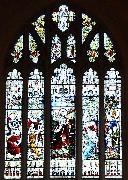 |
Jean-Baptiste Capronnier
|
|
(1814-1891) was a Belgian stained glass painter. Born in Brussels in 1814, he had much to do with the modern revival of glass-painting, and first made his reputation by his study of the old methods of workmanship, and his clever restorations of old examples, and copies made for the Brussels archaeological museum. He carried out windows for various churches in Brussels (including the Église Royale Sainte-Marie), Bruges, Amsterdam and elsewhere, and his work was commissioned also for France, Italy and England. At the Paris Exhibition of 1855 he won the only medal given for glasspainting. He died in Brussels in 1891.
|
|
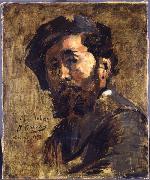 |
Jean-Baptiste Carpeaux
|
|
(May 11, 1827 - October 12, 1875) was a French sculptor and painter.
Born in Valenciennes, Nord, son of a mason, his early studies were under François Rude. Carpeaux entered the Ecole des Beaux-Arts in 1844 and won the Prix de Rome in 1854, and moving to Rome to find inspiration, he there studied the works of Michelangelo, Donatello and Verrocchio. Staying in Rome from 1854 to 1861, he obtained a taste for movement and spontaneity, which he joined with the great principles of baroque art. Carpeaux sought real life subjects in the streets and broke with the classical tradition.
While a student in Rome, Carpeaux submitted a plaster version of Pe - heur napolitain e la coquille, the Neapolitan Fisherboy, to the French Academy. He carved the marble version several years later, showing it in the Salon exhibition of 1863. It was purchased for Napoleon III's empress, Eugenie. The statue of the young smiling boy was very popular, and Carpeaux created a number of reproductions and variations in marble and bronze. There is a copy, for instance, in the Samuel H. Kress Collection in the National Gallery of Art in Washington D.C.. Some years later, he carved the Girl with a Shell, a very similar study.
In 1861 he made a bust of Princess Mathilde, and this later brought him several commissions from Napoleon III.
|
|
|
|
 |
Jean-Baptiste-Camille Corot
|
|
was a French landscape painter and printmaker in etching. Corot was the leading painter of the Barbizon school of France in the mid-nineteenth century. He is a pivotal figure in landscape painting and his vast output simultaneously references the Neo-Classical tradition and anticipates the plein-air innovations of Impressionism.
|
|
|
|
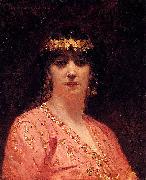 |
Jean-Joseph Benjamin-Constant
|
|
(also known as Benjamin Constant), born Jean-Joseph Constant (10 June 1845 - 26 May 1902), was a French painter and etcher best known for his Oriental subjects and portraits.
Benjamin-Constant was born in Paris. He studied at the Ecole des Beaux-Arts in Paris, where he was a pupil of Alexandre Cabanel. A journey to Morocco in 1872 strongly influenced his early artistic development and lead him to produce Romantic scenes under the spell of Orientalism. Among his noted works in this vein are Last Rebels, Justice in the Harem (both in the Luxembourg Gallery), Les Cherifas, and Moroccan Prisoners (Bordeaux). His large canvas, The Entrance of Mahomet II into Constantinople (Toulouse Museum), received a medal in 1876.
After 1880, he changed his manner, devoting himself to mural decorations and to portraits. Prominent examples include the great plafond in the Hôtel de Ville, Paris, entitled Paris Convening the World; his paintings in the New Sorbonne, representing Literature, The Sciences, and the Academy of Paris; and the plafond of the Opera Comique theatre. He was distinguished as a portrait painter, especially in England, where he was a favorite of the aristocracy. His portrait Mons fils Andra (Luxembourg) was awarded a medal of honor at the Salon in 1896.
Benjamin-Constant painted Pope Leo XIII, Queen Alexandra of England (1901), Lord John Lumley-Savile, and Henri Blowitz (1902). He was made a member of the Institute in 1893, and was a commander of the Legion of Honor. He visited the United States several times, and painted a number of portraits. The Metropolitan Museum of Art in New York owns a large mural decoration by Benjamin-Constant entitled Justinian in Council.
|
|
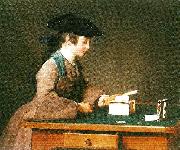 |
jean-simeon chardin
|
|
Jean-Baptiste-Simeon Chardin, född 2 november 1699 i Paris, död 6 december 1779 i Paris, var en fransk målare. Mästare på stilleben och genrebilder.
Chardins blygsamma läggning, personliga stil och valet av motiv från medelklassens vardagsliv försenade hans succe i Bouchers och Fragonards Frankrike, men 1728 invaldes han i Franska akademin samtidigt som hans genrebilder genom gravörernas försorg blev populära.
När 1700-talets hovkonst inte längre var populär, steg Chardins popularitet. De enkla kompositionerna, de ensamma gestalterna i form av köksflickor i arbete eller barn försjunkna i sina lekar, påverkade målare som på 1800-talet målade vardagsmotiv. Manet influerades starkt av den lugna klarheten i Chardins stilleben, liksom Courbet hade påverkats före honom. |
|
|
|
jeremy collier
|
|
1650 C 1726, English clergyman. Collier was imprisoned as one of the nonjurors, who refused to pledge allegiance to William III and Mary II. He later was outlawed (1696) for absolving on the scaffold two of those involved in the assassination plot against William. Collier's principal fame comes from his Short View of the Immorality and Profaneness of the English Stage (1698) and Ecclesiastical History of Great Britain (1708, 1714). In 1713 he was ordained a nonjuring bishop. |
|
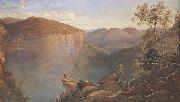 |
JH Carse
|
|
Australian Painter, ca.1819-1900 |
|
|
|
|
|
|







